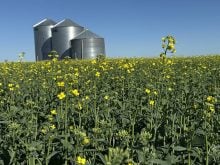As American grocery buyers await a Federal Trade Commission verdict on Kroger’s two-year-old, US$24.6-billion bid to buy its competitor, Albertsons, the European Commission took just 35 days to give its blessing to the merger between two of the world’s largest grain merchandisers, Bunge and Viterra.
The mega-deal, valued at about $34 billion at the time of its June 2023 announcement, isn’t a slam dunk. Canada, where both companies own substantial export facilities in Vancouver, is holding up approval as it evaluates the deal’s impact on western Canada’s grain markets. And for good reason.
Bunge, the world’s fifth-largest grain merchant, operates in 40 countries and has about $57 billion in annual revenues. It’s the world’s largest oilseed processor and globally dominant in soybeans, canola and corn, notes a recent 92-page report on the deal by SOMO, an Amsterdam-based, independent agency that examines corporate power in business, politics and culture.
Read Also

Manitoba data in on Maizex canola hybrids
Maizex Seeds has two new canola hybrids for western Canadian farmers to plant for the 2026 crop. The latest Manitoba trial data is in on the new varieties.
Viterra is no slouch, either. Owned by mining giant Glencore, it has extensive grain processing and export facilities in 38 countries and in 2023 had revenues of $53 billion. Together, the pair would challenge industry cornerstones.
“The proposed transaction … will create a global grain giant to rival Cargill and Archer Daniels Midland, further contributing to the consolidation of the crucial commodity trading and logistics segment of the global food value chain,” said SOMO.
That type of latent market power, noted Canada’s National Farmers Union, belies Viterra’s deep roots in the Prairie co-operatives that built Canada’s grain handling system over the course of nearly a century.
Those co-ops — founded, funded and fueled by farmer members — developed an “elevator system to gain control of the (local grain) trade” and “operated as profitable farmer-run businesses that handled nearly 60 per cent of Canada’s grain from country elevator to port terminal,” the NFU said.
When the North American Free Trade Agreement went into effect in the mid-1990s, however, the Prairie co-ops and the nation’s single-desk export agent, the Canadian Wheat Board, lost political favour with the newly installed Conservative Stephen Harper government.
Shortly thereafter, the farmer’s union said, the “Harper government stripped the CWB of its authority” which quickly “… led to restructuring that ultimately and controversially converted these farmer-created co-operatives into the corporation that rebranded as Viterra in 2007.
“If Bunge is allowed to buy Viterra, it will get billions of dollars worth of revenue potential created by and for Canadian farmers to counter the very exploitation of private grain traders like Bunge visited on them a century ago,” warned the union in a Sept. 3 opinion piece.
It’s not idle speculation. A March report on the Bunge-Viterra (BV) deal by three University of Saskatchewan ag economists showed that “by any measure the grain industry in Canada is already very concentrated and will only become more concentrated with a BV merger.”
The trio then tested their hypothesis. A “merger simulation indicates that Vancouver export basis will increase by about 15 (per cent)… while canola crush margins will increase by 10 (per cent).” Added together, the total impact of the proposed Bunge-Viterra deal “reduces grain producer income by approximately C$770 million per year.”
Outside of Canada, says SOMO, the merger is equally troubling.
“It will significantly contribute to the consolidation of the global agribusiness sector by creating the world’s largest grain trader (that can) undermine the resilience of food supply chains, economic democracy, and food security and sovereignty.”
It’s a story almost as old as agriculture itself. Companies accumulate market power to squeeze otherwise unobtainable revenue from their market’s least protected, most vulnerable players. And who is less protected and more vulnerable to predatory global grain giants than farmers?
The Farm and Food File is published weekly throughout the U.S. and Canada. Past columns, recommended reading and contact information are posted at farmandfoodfile.com.















